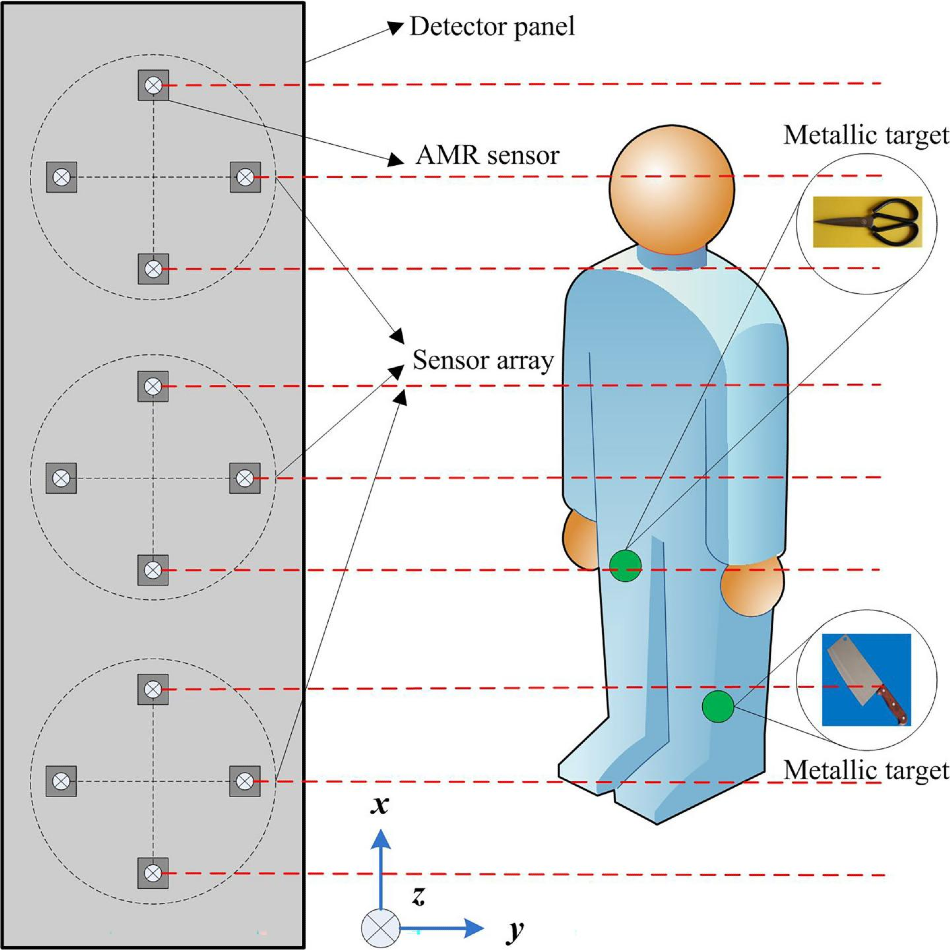Jan 22 2020
Hidden metal objects are usually detected by conventional electromagnetic techniques, a majority of which involve large and heavy systems that need more electricity.
 The magnetic gradient full-tensor fingerprints-based security system using anisotropic magnetoresistance sensor arrays. Image Credit: Huan Liu.
The magnetic gradient full-tensor fingerprints-based security system using anisotropic magnetoresistance sensor arrays. Image Credit: Huan Liu.
In most recent research works, it has been observed that metallic objects have unique magnetic fingerprints that are based on their shape, size, and physical composition. In a study published recently in the AIP Advances journal, from AIP Publishing, researchers have reported how these observations can be leveraged to potentially develop a smaller and less expensive system that is as effective as its larger equivalents.
The researchers showed how a new kind of magnetic-based metal detection security system based on magnetic fingerprinting can be used to more efficiently detect hidden metal objects. The device made use of materials in an evolving field, called weak magnetic detection, to detect a broad range of metallic objects, spanning from hammers to cellphones.
The early outcomes were useful in promoting magnetic fingerprinting as a viable means toward achieving security detection.
The achievement of applying magnetic anomaly detection technology in magnetic sensor arrays promises smart public security sensing systems with low cost, small size and low power budgets. Unlike other electromagnetic detection methods, it doesn’t require someone to walk through a door framework and can be built in a compact size.
Huan Liu, Study Author, China University of Geosciences
A majority of the existing security metal detectors work only if the user actively searches for a metallic object, which usually involves the use of some type of radiation. Such active screening necessitates machines to be large and consume a lot of energy.
However, the device developed by the research team has the ability to work in a passive mode, considerably minimizing the energy needed to operate. In addition, this prospectively enables the technology to be portable, without depending on the constrained, threshold type of metal detectors that are most commonly used by people.
The technique involves combining three arrays of anisotropic magnetoresistance sensors with a microcontroller, battery, and computer. The researchers collected 2D magnetic data and created a computer workflow for processing the data and its fingerprint, which eliminates the noise.
The technique could detect fingerprints of objects measuring more than 16 inches and detect several objects separated by a distance of less than 8 inches.
The major challenge in designing a weak magnetic detection-based public security system may lie in the difficulty to distinguish the weak object signals, like scissors and hammers, from unknown interference, which would decrease the signal-to-noise ratio and the range of the detection zone.
Huan Liu, Study Author, China University of Geosciences
As a next step, the researchers intend to further optimize the potential of the device to accurately detect fingerprints from farther distances.
The study titled “Magnetic gradient full-tensor fingerprints for metallic objects detection of a security system based on anisotropic magnetoresistance sensor arrays” was penned by Huan Liu, Xiaobin Wang, Junchi Bin, Haobin Dong, Jian Ge, Zheng Liu, Zhiwen Yuan, Jun Zhu, and Xinqun Luan.